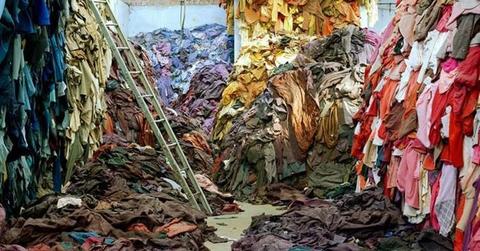
Fashion Is F’in Up Our Environment
By Emilie Marie BreslinDec. 13 2018, Updated 3:35 p.m. ET
The fashion carbon footprint is currently the second largest polluter in the world, and Fast Fashion is its main problem. Fast Fashion, low-cost highly fashionable garments sold by giant brands, are destroying the environment at this point.

Photo Credit: Carmen Busquets
According to EcoWatch, “a general assessment must take into account not only obvious pollutants – the pesticides used in cotton farming, the toxic dyes used in manufacturing and the great amount of waste discarded clothing creates – but also the extravagant amount of natural resources used in extraction, farming, harvesting, processing, manufacturing and shipping.”
The entire process of creating clothes, producing, and shipping them to consumers all over the world creates a harmful pattern. Developing countries in particular deal with the backlash of pollution first hand – in water supplies, food, air quality, and more; it’s everywhere.
What is Happening?
“Since 2000, global clothes production has more than doubled, and the average person now buys 60 percent more items of clothing every year and keeps them for about half as long as they did 15 years ago. In the USA, over 85 percent of those clothes end up in a landfill.” So, people are buying more clothes and getting rid of them faster. Developed countries, specifically, are affected by this trend with constant technological changes and live more of a “go-go-go” lifestyle with the internet.
Polyester, a cheap substitute for natural fibers, is a main reason the industry is causing such harm. A single polyester garment can shed >1900 micro plastic fibers per wash, which enter the water system and ultimately our oceans. Fish consume those microplastics and we consume that fish. The synthetic resin fiber takes 20 to 200 years to break down, whereas natural textiles like silk, cotton and wool only take about a year. It also requires an extensive amount of water and dye to produce the substance.

Photo Credit: ABC News
So What’s Next?
The best way to clean out your closet is by donating unwanted clothes to charities for the poor and homeless, or even to second-hand stores for the smart shopper. What people don’t realize is if clothes are undesirable in charities and/or thrift stores, those locations then sell those clothes all over the world. A charitable donation becomes a trading commodity, and helps more people than you could imagine. If clothes don’t find this mold, then the unwearable garments are broken down into rags and shreds that end up stuffing mattresses, upholsteries etc.
According to Eco Warrior, you should:
- Question yourself: Do you need it?
- Research
- Buy Second Hand
- Use Eco-Friendly Fabrics
- Shop Local
- Choose Quality
- Bring a Reusable Bag
- Say “No” to Packaging
- Wash Less
- Make it Last

